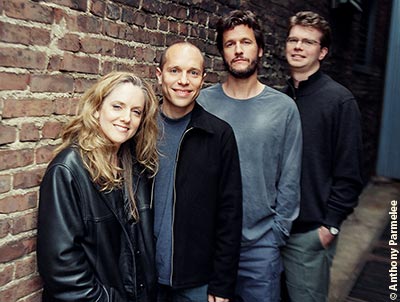|
Music TORONTO, in their 35th season of Chamber Music Downtown, served up the most appetizing menu of the St. Lawrence String Quartet or “SLSQ”, and husband and wife team, cellist David Finckel and pianist Wu Han, at the St. Lawrence Centre.
“There’s no substitute for live music”, emphatically stated one couple who have been attending this Chamber Music series for a number of years. Echoes of “Fantastic” and “Wonderful” resounded during the intermission break. Audience members quickly returned to their seats long before the warning chimes had sounded. Laughter, gaiety and sheer joy had not been equalled since just before intermission. But we’re ahead of ourselves. What occurred to cause this otherwise serious and discriminating audience to carry on as though they were about to receive a much longed-for gift?
|
|
St. John gives new meaning to the concept of ‘playing with your entire body’. He nearly leaps out of his chair, that is, when it is fully grounded. At one point during the performance of Arensky’s String Quartet in the second half of the performance, I actually heard his shod feet stomp twice in time with the emphatic two notes he was playing, seemingly unable to restrain his musical passion. This is not unusual for St. John as one of his teachers is said to have actually placed sofa cushions beneath his feet during lessons to deaden the sound. This passionate exuberance actually added to the audience’s enjoyment. But again, we’re ahead of ourselves.
Back to the first part of the evening. From Allegro to Adagio, Vivace to Andante, each movement of Dohnányi’s Serenade was played lyrically, with total absorption and minute attention to contrast and texture, building for the Rondo finale. One of the SLSQ’s founding members, Lesley Robertson, opened the second Romanza movement, with her viola taking the melody and carrying the audience right along. The violin then took the melody for the rest of this extraordinarily powerful segment. Cellist Christopher Costanza comments that Dohnányi solves the challenge of using only one violin in this work for a trio, through “filling out the textures by cleverly enriching the parts of each of the three instruments. The music itself is delightful and charming, building upon the melodic strengths of the instruments and layering musical lines in appealing ways.” Even Costanza’s comments speak of the work as an almost living, enticing entity. It’s no surprise to find that Béla Bartók, a fellow Hungarian composer and contemporary of Dohnányi, stated that “You can sum up Hungarian music in one word, Dohnányi.”
Just prior to intermission, the dramatic performance of David Finckel and his wife Wu Han, of Shostakovich’s Sonata in D Minor for cello and piano, Opus 40, captivated the audience. Wu Han’s fingers flew over the keyboard with such passion and energy, it was amazing she could sustain the frenetic pace. Then, the music ended so abruptly, the audience jerked and one listener involuntarily let escape a guffaw of surprise and tension. Enquiring of Wu Han if this sort of reaction were unusual, she smilingly jested, “If they don’t have that reaction, we have to work harder the next time”. The intermission was required recovery time.
Playing second cello to Christopher Costanza for the Arensky String Quartet in A Minor, Opus 35, Finckel slid seamlessly into the group as though they had played together for many years. Russian composer Anton Arensky, one time teacher of Rachmaninoff and student of Tchaikovsky, distinctively combined two cellos, one violin and a viola for the technically challenging three movements which run the full gamut of emotions. Cellist Costanza considers this work, “a pure delight from the perspective of the performers — tuneful, contrapuntally complex, and texturally warming and comforting.” The audience agreed.
The timing of this quartet is superb. Hitting the notes on the beat is a requirement. Placing the notes in the exact middle of the beat, is the sign of a master. In a similar way, hitting the note on pitch is also a requirement, but hitting, what I like to think of as the ‘sweet spot’ of the note, is mastered by few. ‘Itzhak-like’ is the only description for St. John’s musical vibrancy, tonal richness and interpretive involvement.
It’s a rare treat to listen to a group of musicians who play as though they are one. Performers with ample stage presence quickly communicate their feelings to the audience, faster than the sound emanates from their instruments. That the SLSQ immensely enjoy their craft was evident in every note, stomp, smile and beat of their music and brought great joy to the audience. This is music as it should be. This is the kind of performance that brings Rock N’ Rollers over to the other side. This is live music at its best. This is the St. Lawrence String Quartet.
|


